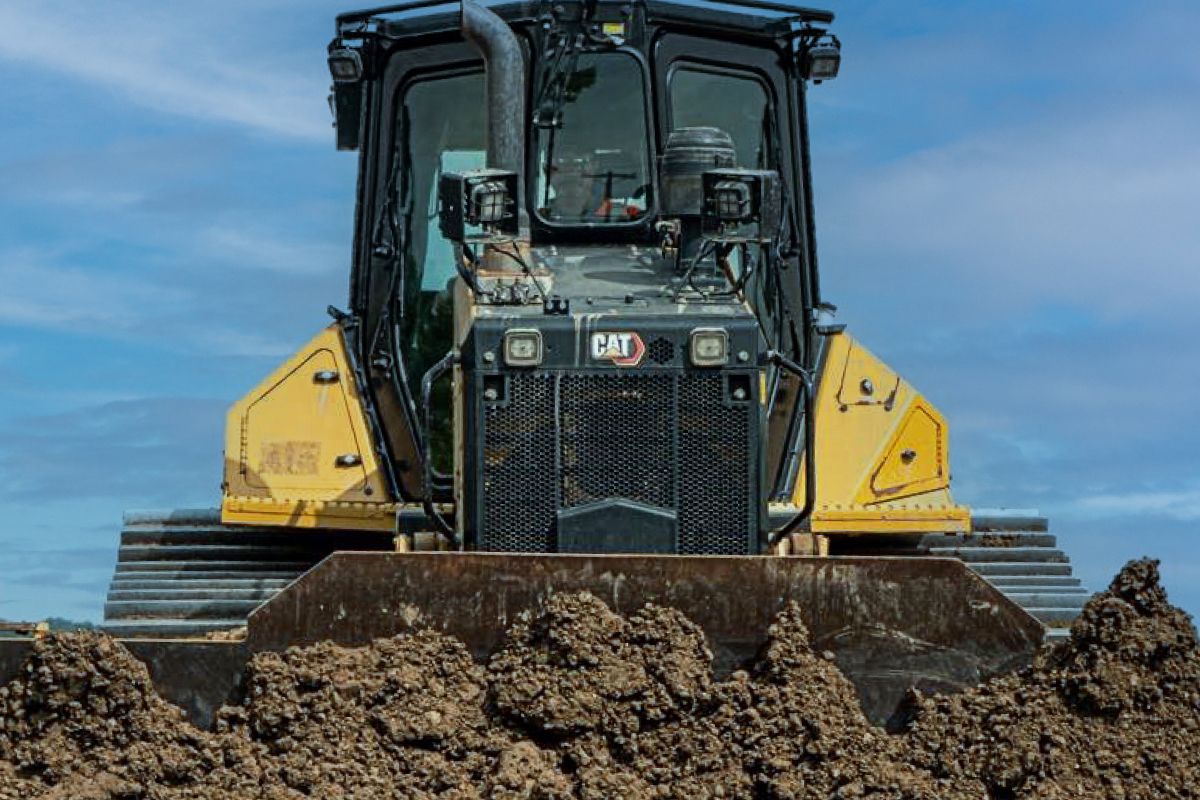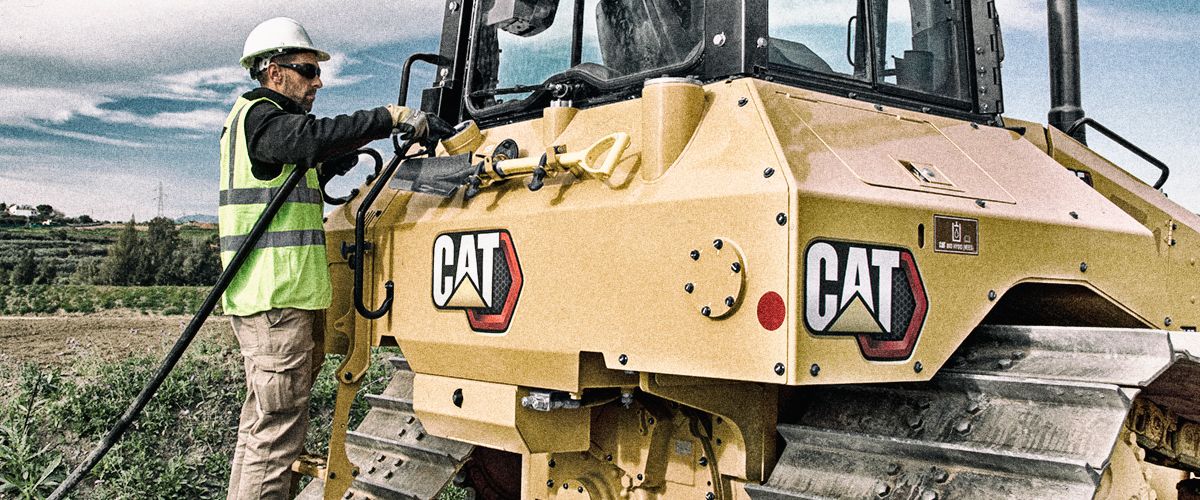The work is a lot harder than it sounds, especially the stump clearing. Current logging industry practices compel contractors like Patterson & Son to wait seven to 10 months after the harvest before they can go in and begin to prepare a site for replanting. That gives the stumps just enough time, Ricky says, to “get seasoned.”
“If you can move in right after the logger,” he says, “those stumps are green and you can make pretty good time. Or if you wait a year and a half, then they start to decay and, again, you can make pretty good time.
“But if you go in when we go in, you catch them right at the worst time. They’re hard as iron or cement.”
Think of the stumps as Nature’s equivalent of those anti-vehicle barriers you see outside government buildings these days.
For six decades, Patterson & Son have been driving their Cat dozers into them over and over and over again.
One acre an hour.
Ten hours a day.
Five and sometimes six days a week.
“It’s brutal,” says Ricky, who bench presses more than 400 pounds and doesn’t look like a guy who bruises easily.
‘LIKE A ROCK’
So how did the Cat machines perform in this decades-long “brutal” field test at the hands of Patterson & Son?
Well … Ricky, now 54, seems to have recorded his assessment on his left bicep, where he has tattooed a D6 dozer and written underneath “Like a rock.”
“When Ricky showed that tattoo to me for the first time,” says Art Catoe, the product support general sales manager at Cat dealer Blanchard Machinery, “it was one of those situations where you have to recover and kind of compose yourself. Then you hear yourself saying, “I really like that, Ricky. Let me get a picture.’”
Ricky has turned the family’s old machine shop into a great entertainment room filled with Cat memorabilia. Step outside and you’ll see where he and his boys work out. It’s in the outbuilding with the big “Cat Power Lifting” banner on it. In the garage next door, Ricky parks his Dixie Chopper brand commercial mower, which he recently bought – even though he already had a ride-on mower – after the local dealer pointed out it had a Cat engine in it.
“I just had to have it,” he laughs.
Passion for Caterpillar runs in the Patterson family. When Ricky was a boy, his dad owned two race cars that his uncle Frankie Elliott drove at the speedways in the state. Both were painted Cat yellow. One was named “D7.” The other was named “D8.”
“My daddy always said ‘I’d rather have a serial number plate off a Cat than a brand new machine from somebody else because with that serial number plate at least I know I got something,’” he says.
“No matter what the situation, no matter how bad it gets, Caterpillar has never failed to stand behind us. They are No. 1 for the customer.”
But Ricky insists the family’s fanaticism is a function of the equipment’s superior performance in a punishing application. Over the decades, he says he has watched as newcomers that underestimated the difficulty of the work and over-estimated the capacity of their non Cat equipment tried unsuccessfully to break into the stump-busting business. Catoe, who joined Blanchard in the 1980s, has seen it too.
“In my 30 years, there’s been a bunch that come in but they don’t stay very long because it is hell on a machine,” Catoe says.
Ricky knows all his competitors who have stood the test of time. All five of them, he says, run Cat equipment exclusively.
“There’s no way that a John Deere or a Komatsu or these other off-brands can build a machine in this application that will stand up,” Ricky says.
“Cat [machines are] just built better. You can take the wrist pin off the crank shaft on a Cat machine and take one off a competitor and the Cat machine is almost twice as big. It’s built. It’s built to be there. It’s built to last.”
PUNISHING APPLICATION
Patterson & Son’s D6s are outfitted with special blades made by a Georgia company called Savannah Forestry Equipment. The strength of the Cat dozers, even in the muddiest conditions, coupled with the strength of the Savannah blade – forged from special steel called AR400 -- make the stump-shearing work relatively straightforward, though it’s not an especially elegant process to watch as the dozers crisscross the field.
“The reason we cut back and forth,” Ricky says, “is if we’re going through here and we see a big old stump to our left, we can go and bust it in half so when we come back the other way we can cut the other half off. Especially in a wet place, you have to think ahead.”
What makes the work hard is the punishment it inflicts on the dozer’s undercarriage, the system of sprockets, track shoes, pins, bushings, idlers, links and frame inside the track-chain that moves the machine forward and backward.
As the dozer crawls over the stumps and other debris in the field, the track chain flexes back and forth. That’s no problem for the track itself, but it exerts extraordinary pressure on the rail portion of the undercarriage. Over time, that can cause the seals on the rail to fail and to quickly bring all work to a halt.
Those punishing conditions made Patterson & Son’s tractors especially useful as Caterpillar worked in recent years to field test new undercarriage technologies like Cat SystemOne™ in the most extreme conditions and toughest environments.
Back in the old days, before lubricated rails, dry-link undercarriages wouldn’t last more than 600 hours out here, Ricky says. “They wouldn’t break. But the internal wear was awful. When you opened it up it looked like a snake,” he says.
The development of lubricated undercarriage systems, like Caterpillar’s SystemOne with its rotating bushing, has tripled the life of the undercarriages on Patterson & Sons’ Cat tractors. Ricky is pushing for more and confident he’ll reach his goal with help from Blanchard and Caterpillar engineers.
“If anyone is going to solve a problem or build a better machine, it’s Caterpillar. There’s no doubt in my mind.”
In the meantime, he says SystemOne has already demonstrated its cost effectiveness, reducing Patterson & Son’s maintenance and repair downtime and part replacement costs.
“For someone out there doing a normal job, SystemOne can’t be beat. They’re liable to get 6,000 hours of wear on it.”







